Many restaurants or cafes offer modern dessert on their menu. We are familiar with ice cream, frozen yoghurt, or fruit pudding in many shapes. But do you know that Indonesian traditional culinary also have variety of desserts?
Traditional dessert refers to dessert made of local ingredients and it is usually made without much reliance on technology or any food processing technique. While traveling in Indonesia, eating cold and icy dessert will soften our palate after eating spicy foods. These Indonesian icy desserts will complete your culinary experience.
- Kolak
Kolak is a viscous soup, usually contained banana and tubers cuts like cassava or yam. The soup is made of water, brown sugar, and coconut milk. They are put together in a pot on top of the stove until they are boiled.
When the soup becomes a bit thick, then the kolak is ready to serve. Kolak is a mandatory food in Ramadhan. Eating kolak with ice cube will shoot fresh our mouth after a full day fasting. Read more about Ramadhan tradition in Indonesia to have better knowledge about the tradition.
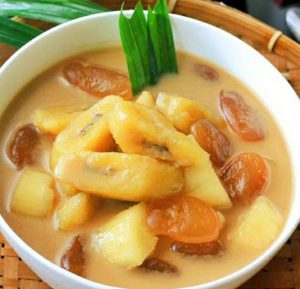
- Es Pisang Ijo
Es pisang ijo is a dessert often found on the streets in the middle of the day. The main ingredient is banana rolled with sweet green sticky flour. The roll is cut into smaller pieces and poured with sweet melon or strawberry syrup.
Sometimes there are variety of toppings like peanut, bread, or jelly. It is best served with shaved ice. Originally Es Pisang Ijo is Makassar specialty, one of popular cuisine in South Sulawesi. But you can also find it in cities in Java.
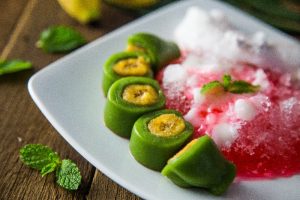
- Bubur Kacang Hijau
In Indonesia, mung bean is used as ingredients of many foods. One of the simple way to eat the mung bean is to make it into watery porridge. You soak the mung bean in the water for at least few hours to one night to soften the beans. Then the soaked beans are put into a pan with water until boiled and have softer texture and the water is reduced.
Add coconut milk and brown sugar to make thick and sweet soup. Wait until the mix is boiled again. Serve it with ice cubes to increase the freshness. Bubur kacang hijau is easily found in the morning because the natives usually eat it for breakfast.
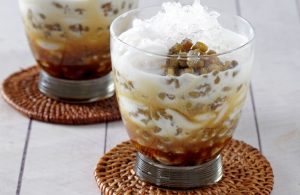
- Fruit Soup
Indonesia is filled with many variety of fruits. They are fresh, plump, and rich in flavor. Some fruits are available throughout the year, but some will have to wait until harvest season to enjoy. The most simple way to enjoy many variety of fruits is to make a bowl of fruit soup.
Fruits like mango, coconut, avocado, apple, watermelon, pineapple, melon, and grape are cut into small pieces and put into a bowl. You can add melon or strawberry syrup and some milk into the bowl, together with shaved ice. Fruit soup is the best dessert to have in a sunny day.
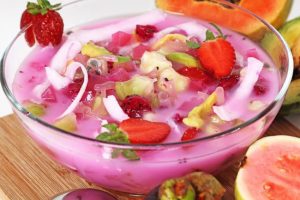
- Es Doger
It is a unique dessert which use black sticky rice, shaved ice, pearl shaped pulp, poured with syrup and coconut milk. Sometimes they add bread cuts as the topping.
The black sticky rice is the highlight of the menu since it gives unique flavor like eating sweet and chewy rice. Because of that, es doger is a bit filling for dessert.
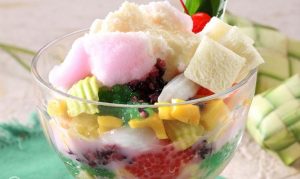
- Es Kado/Es Potong
Es potong or es kado has been around for decades as street dessert favored by children. It is shaped as a long bar or long tube ice, wrapped up with paper.
When served, the bar is cut into shorter shape and pricked with bamboo stick as the handle. It has classic fruit flavor like strawberry, mango, durian, melon, and sometimes jackfruit.
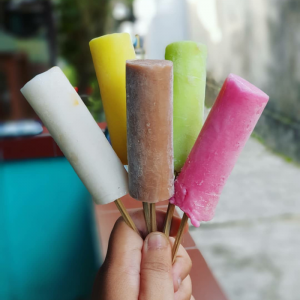
- Bubur Mutiara
Bubur mutiara is made of pearl shaped pulp from rice flour. The pulps are boiled with water until they swell and give sticky texture. To get a sweet taste, some spoons of white sugar are added before pouring the coconut milk. Bubur mutiara is popular dessert in Central Java and Yogyakarta area.
It is usually sold on the same food stall which sells mung bean Bubur Kacang Hijau (mung bean porridge) and black sticky rice porridge as an alternative for light breakfast, lunch, or dinner. It is one of the tasty street food in Indonesia.
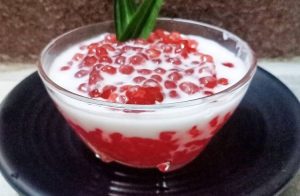
- Es Kolang-Kaling
Another delicious and unique dessert often made in Ramadhan. Kolang kaling is sugar palm fruit that has been processed through several steps to create soft yet a bit chewy texture. Originally, sugar palm fruit has a hard skin and the sap triggers allergic reaction when we directly touch it.
After peeling the skin, the fruit inside needs to be cleaned thoroughly with rice water before boiled. Then you still have to soak the boiled fruit in the water for several nights to get rid of other allergens until you get soft and chewy texture.
For serving, it’s usually used ad additional ingredients for kolak. But you can make your own Es Kolang Kaling by adding syrup or sugar, fruits, mineral water, and many of ice cubes.
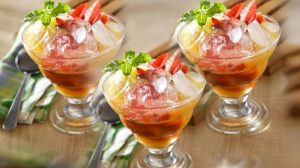
Ramadhan is the best time to visit if you want to try Indonesian traditional dessert. Many food stalls sell homemade dessert to enjoy after fasting.
Dessert like Es Kolang Kaling and Kolak are rarely sold in daily basis. But if you want to try Es Doger, Bubur Mutiara, Bubur Kacang Hijau, Fruit Soup, or Es Potong, you can easily find them in the portable food stalls on the street. They are tagged with super cheap price.
A bowl of those 8 Indonesian traditional dessert is no more than IDR 10.000. If you happen to visit Indonesia in Ramadhan or Eid Al-Fitr holiday, don’t forget to try The All-time Favorite Lebaran Dishes from Indonesia.
Those are the most-known Indonesian traditional dessert you have to try at least once in your visit in Indonesia. After tasting those desserts, you can try these Indonesian traditional cakes.
